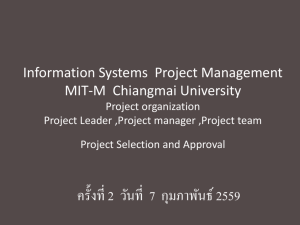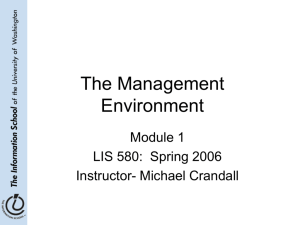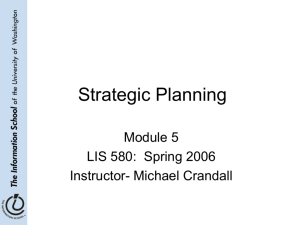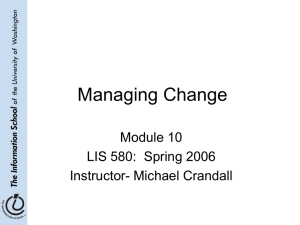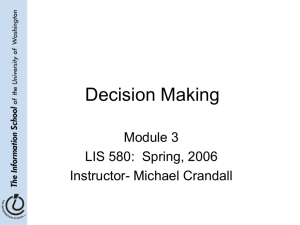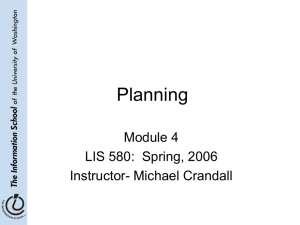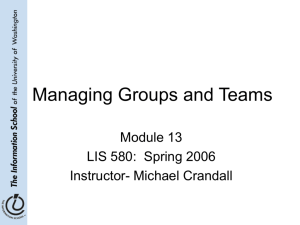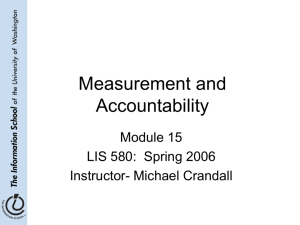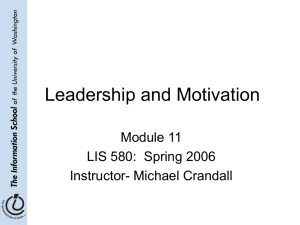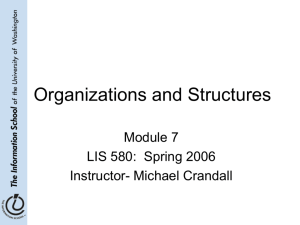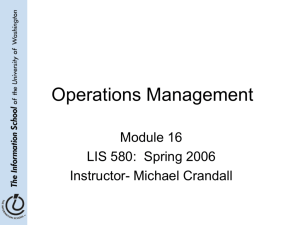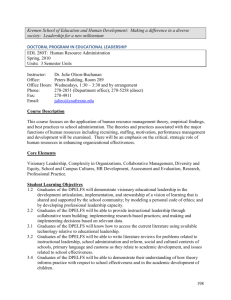Document
advertisement
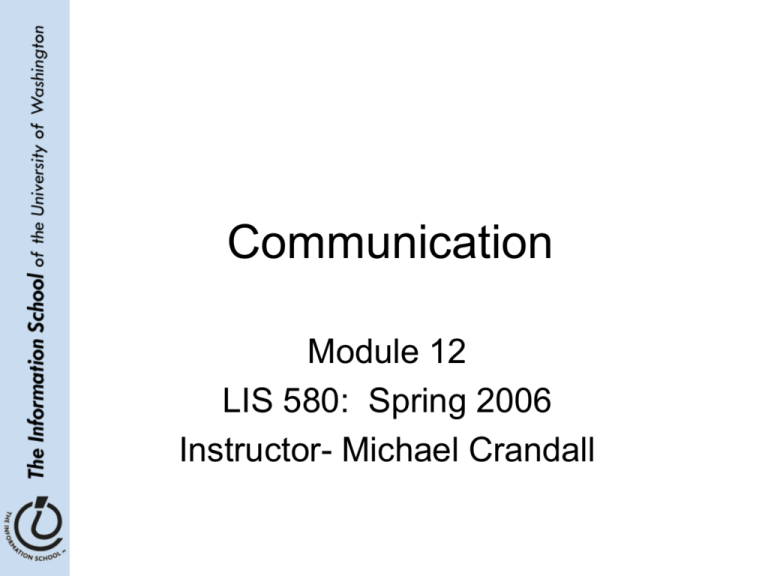
Communication Module 12 LIS 580: Spring 2006 Instructor- Michael Crandall Roadmap • • • • • • • • The communication process Barriers to communication Interpersonal communication Negotiation Organizational communication Barriers to organizational communication Electronic communication Conflict May 4, 2006 LIS580- Spring 2006 2 Communication • Creating joint meanings and shared understanding • Coordinating (the coordination of) behavior • The exchange of information • Information as a common basis of human relationships, understanding, and feeling Prentice Hall, 2002 May 4, 2006 LIS580- Spring 2006 3 Emotional Intelligence Again • In “Leading by Feel” several leaders discuss emotional intelligence and its impact in organizations • What common themes did you see in these short pieces? • How does paying attention to emotional intelligence help in communication? • Is it only the leader’s emotional intelligence that matters? • Why do you think communication is so difficult in organizations? May 4, 2006 LIS580- Spring 2006 4 The Communication Process FIGURE 12–1 G.Dessler, 2003 May 4, 2006 LIS580- Spring 2006 5 Barriers to Effective Communication • • • • • • • Ambiguous, Muddled Messages Semantics Physical Barriers Loss of Transmission Failing to Communicate Competition Barriers Cultural, Linguistic, and Diversity Barriers • Not Listening G.Dessler, 2003 May 4, 2006 LIS580- Spring 2006 6 Nonverbal Communication • Nonverbal Communication – The nonspoken aspects of communication, such as a person’s manner of speaking, facial expressions, or body posture, that express meaning to others. – Nonverbal communication can complicate the task of communicating internationally. • The nonverbal part of communicating is more important in some societies than in others. • In many societies, the context (or setting) in which a message is delivered, with its nonverbal cues, has far more meaning than the words of the message itself. G.Dessler, 2003 May 4, 2006 LIS580- Spring 2006 7 Psychological Barriers • Perception – Selectivity/exposure filtering out of unpleasant things and focusing on or recalling things not heard. – Retention filtering of things that feel good, and the tendency to forget those things that are painful. • Experiential Barriers – The difficulty in understanding things not personally experienced. • Emotions – Emotions influence both what is said and what is heard. • Defensiveness – Adjustments people make to avoid acknowledging personal inadequacies that might reduce their self-esteem. G.Dessler, 2003 May 4, 2006 LIS580- Spring 2006 8 Interpersonal Communications • Interpersonal communication – Communication that occurs between two individuals. • Methods for Improving Interpersonal Communications – Pay attention – Make yourself clear – Be an active listener – Don’t attack the person’s defenses – Get feedback G.Dessler, 2003 May 4, 2006 LIS580- Spring 2006 9 Checklist 12.1 Active Listening Listen for total meaning. Reflect feelings. Note all cues. Give the person your full attention. Show that you are listening with an open mind. Encourage the speaker to give complete information. G.Dessler, 2003 May 4, 2006 LIS580- Spring 2006 10 Negotiation • Negotiation defined – A process in which two or more parties who have different preference must make a joint decision and come to an agreement • Distributive bargaining – Negotiation under zero-sum conditions, in which the gains by one party involve losses by the other party • Integrative bargaining – Negotiation in which there is at least one settlement that involves no loss to either party Prentice Hall, 2002 May 4, 2006 LIS580- Spring 2006 11 Determining the Bargaining Zone Prentice Hall, 2002 May 4, 2006 LIS580- Spring 2006 12 How to Improve Your Negotiating Skills • Mistakes to avoid when negotiating: – – – – Neglecting the other side’s problems. Letting price overwhelm other interests. Searching too hard for common ground. Failing to consider BANTRAs (best alternative to a negotiated agreement). • Negotiating Tactics (Using Leverage) – – – – Necessity Desire Competition Time G.Dessler, 2003 May 4, 2006 LIS580- Spring 2006 13 Checklist 12.2 How to be More Persuasive Establish your credibility. Frame for common ground. Connect emotionally. Provide evidence. Use peer power whenever it’s available. Have the person make the commitment active, public, and voluntary. G.Dessler, 2003 May 4, 2006 LIS580- Spring 2006 14 Organizational Communication • Organizational Communication – Communication that occurs among several individuals or groups. • Downward communications go from superior to subordinate. • Lateral (horizontal) communications move between departments or between people in the same department. • Upward communications move from subordinates to superiors. G.Dessler, 2003 May 4, 2006 LIS580- Spring 2006 15 Formal vs. Social Structure Rarely do the communication patterns match the formal structure Cross, Rob. A bird's-eye view: Using social network analysis to improve knowledge creation and sharing. IBM Executive strategy report 04Jun2002 http://www1.ibm.com/services/us/index.wss/xs/imc/a1001262 May 4, 2006 LIS580- Spring 2006 16 Multiple Network Dimensions Four dimensional analysis- knowledge, access, engagement and safety Knowledge Network analyzed on only one dimension- knowledge Cross, Rob. A bird's-eye view: Using social network analysis to improve knowledge creation and sharing . IBM Executive strategy report 04Jun2002 http://www-1.ibm.com/services/us/index.wss/xs/imc/a1001262 May 4, 2006 LIS580- Spring 2006 17 The Four Dimensions Rob Cross May 4, 2006 LIS580- Spring 2006 18 Another View • The work network – With whom do you exchange information as part of your daily work routines? • The social network – With whom do you “check in”, inside and outside the organization to find out what is going on? • The innovation network – With whom do you collaborate or kick around new ideas? • The expert knowledge network – To whom do you turn for expertise or advice? • The career guidance or strategic network – Whom do you go to for advice about the future? • The learning network – Whom do you work with to improve existing processes or methods? Kleiner, Art. Karen Stephenson’s Quantum Theory of Trust. strategy+business, 4th quarter, 2002. May 4, 2006 LIS580- Spring 2006 19 Energy • Do you weave relationship development into work and day-today interactions? • Do you do what you say you are going to do? • Do you address tough issues with integrity? • Do you look for possibilities or just identify constraints? • When you disagree with someone, do you focus attention on the issue at hand rather than the individual? • Are you cognitively and physically engaged in meetings and conversations? • Are you flexible in your thinking or do you force others to come to your way of thinking? • Do you use your own expertise appropriately? Cross, R., Baker, W. & Parker, A. (2003). What Creates Energy in Organizations? Sloan Management Review 44(4), pp. 51-57. May 4, 2006 LIS580- Spring 2006 20 Special Barriers to Organizational Communication • • • • • • • Interpersonal Barriers Authority Free Task Speech? Political Identity Organizational Culture Organization Structures G.Dessler, 2003 May 4, 2006 LIS580- Spring 2006 21 Getting Upward Feedback • Request feedback from people whom you trust and who will be honest with you. • If the feedback is too general, ask for examples of specific, recent behavior. • Don’t be defensive, make excuses, or blame others when you hear criticism. • Do not overreact or underreact to feedback. • Once the feedback is complete, summarize what the speaker said to make sure that you understand. • Explain what you are going to do in response to the feedback, do it, evaluate the consequences on performance, and then let the feedback-giver know of the outcome. • Thank the person for his or her concern and advice. Source: Adapted from Paula J. Caproni, The Practical Coach (Upper Saddle River, NJ: Prentice Hall, 2001), p. 21. May 4, 2006 LIS580- Spring 2006 FIGURE 12–2 G.Dessler, 2003 22 Fostering Upward Organizational Communication • • • • Social gatherings Union publications Regular meetings Performance appraisal meetings • Grievances • Attitude surveys • A suggestion system • An open door policy • Indirect measures • E-Mail G.Dessler, 2003 May 4, 2006 LIS580- Spring 2006 23 Improving Downward Communication • Open-Book Management – A management style in which a company opens its books to the employees, sharing financial data, explaining numbers, and rewarding workers for improvement. G.Dessler, 2003 May 4, 2006 LIS580- Spring 2006 24 Improving Horizontal Communication Appoint Liaison Personnel Organize Committees and Task Forces Horizontal Communications Use Independent Integrators G.Dessler, 2003 May 4, 2006 LIS580- Spring 2006 25 Improving Informal Communications Maintain Communication Intensity Emphasize Informality Informal Communications Provide Physical Support G.Dessler, 2003 May 4, 2006 LIS580- Spring 2006 26 Hierarchy of Media Richness and Application for Managerial Applications Source: Adapted from Richard L. Daft and Robert H. Lengel, “Information Richness: A New Approach to Managerial Information Processing and Organization Design,” in Barry Staw and Larry L. Cummings, eds., Research in Organizational Behavior, vol. 6 (Greenwich, CT: JAI Press, 1984), pp. 191–233. Reprinted from R. Daft and R. Steers, Organizations: A Micro/Macro Approach (Glenview, IL: Scott, Foresman, 1986) p. 532. May 4, 2006 LIS580- Spring 2006 FIGURE 12–5 G.Dessler, 2003 27 Managing Conflict • Conflict defined – Perceived differences resulting in interference or opposition • Functional conflict – Conflict over what best supports an organization’s goals • Dysfunctional conflict – Conflict that prevents an organization from achieving its goals Prentice Hall, 2002 May 4, 2006 LIS580- Spring 2006 28 Three Views of Conflict • Traditional view – Assumed that conflict was bad and would always have a negative impact on an organization • Human relations view – Argued that conflict was a natural and inevitable occurrence in all organizations; rationalized the existence of conflict and advocated its acceptance • Interactionist view – Encourages mangers to maintain ongoing minimum level of conflict sufficient to keep organizational units viable, self-critical, and creative Prentice Hall, 2002 May 4, 2006 LIS580- Spring 2006 29 Conflict & Organizational Performance Prentice Hall, 2002 May 4, 2006 LIS580- Spring 2006 30 Sources of Conflict • Communication differences – Arising from semantic difficulties, misunderstandings, and noise in the communication channels • Structural differences – Horizontal and vertical differentiation creates problems of integration leading to disagreements over goals, decision alternatives, performance criteria, and resource allocations in organizations • Personal differences – Individual idiosyncrasies and personal value systems create conflicts Prentice Hall, 2002 May 4, 2006 LIS580- Spring 2006 31 Dimensions of Conflict • Based on work of Kenneth W. Thomas at the Naval Postgraduate School Graduate School of Business and Public Policy http://research.nps.navy.mil/cgi-bin/vita.cgi?p=display_vita&id=1023567855 • Cooperativeness – The degree to which an individual will attempt to rectify a conflict by satisfying the other person’s concerns • Assertiveness – The degree to which an individual will attempt to rectify the conflict to satisfy his or her own concerns Prentice Hall, 2002 May 4, 2006 LIS580- Spring 2006 32 Thomas’ Conflict Model Thomas, K. W. and Kilmann,R. H. Thomas-Kilmann Conflict Mode Instrument. March 19, 2001 http://www.acer.edu.au/publications/acerpress/onlinetesting/documents/TKI.pdf May 4, 2006 LIS580- Spring 2006 33 Next Time • Managing groups and teams and more – • Read Chapter 13 and the assigned articles Discussion questions: – – – – May 4, 2006 These lessons were derived from the military. How much do you think can be transferred to other environments? How do you think a similar examination of leadership behaviors on a basketball team would compare? Given our discussions over the last week about leadership, do you think the “Big 12” behaviors would be effective for team and individual leadership in a library? Why or why not? Is there something missing in this list? If so, what is it? LIS580- Spring 2006 34
